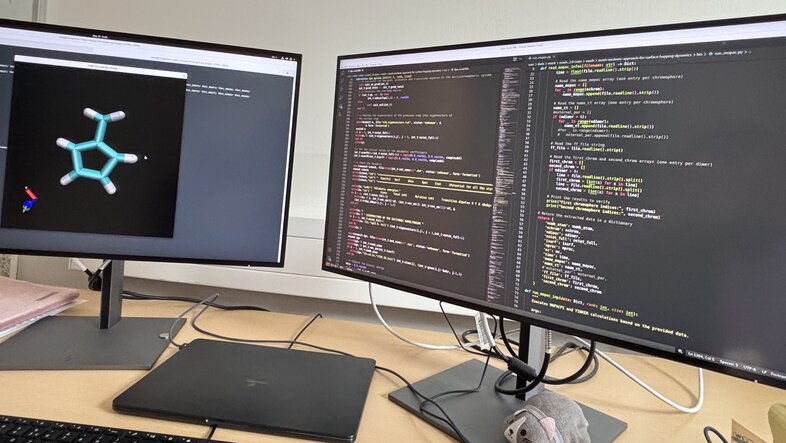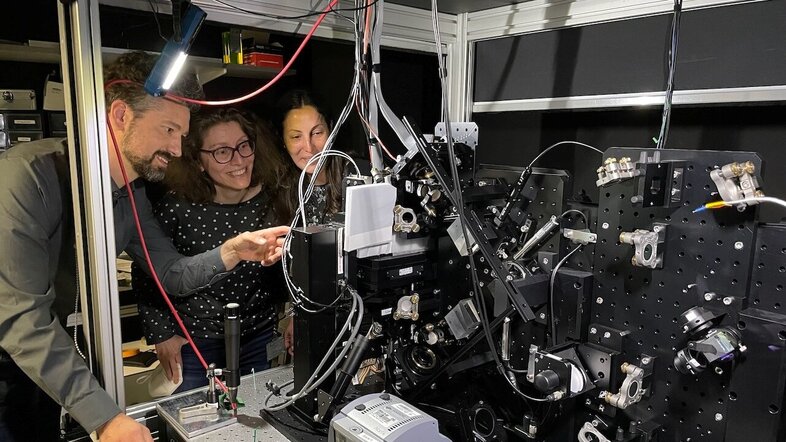How quantum theory shapes science beyond physics
The quantum world of chemistry
Rudolphina: Eduarda Sangiogo Gil, you work at the Department of Theoretical Chemistry and use quantum theory in your research. How is it linked to chemistry?
Eduarda Sangiogo Gil: Quantum theory is important not only in physics, but in chemistry as well. In fact, there is a whole branch of science called quantum chemistry, which focuses on applying quantum mechanics to chemical systems and problems.
Chemistry is the science of matter: its properties, how it changes, and the energy involved in those changes. Matter is made of atoms, which consist of subatomic particles such as electrons, protons and neutrons. The behaviour of these particles cannot be accurately explained by classical physics. Electrons, in particular, do not move like tiny balls along predictable paths. Instead, their behaviour follows the principles of quantum mechanics.
Without quantum theory, our understanding of chemistry would be limited to rough approximations.Eduarda Sangiogo Gil
This is why fundamental concepts such as electron orbitals, energy levels and chemical bonding all stem directly from quantum theory. Furthermore, quantum mechanics provides the tools needed to understand how electrons are arranged in atoms, how bonds form and how reactive different molecules might be. Take electronic energy levels, for example: these can only be described using quantum models. These models are key to understanding how molecules absorb or emit light, how chemical reactions occur, and why certain bonds are stronger or weaker than others.
Therefore, when chemists wish to determine the energy requirements of a reaction, how a molecule might interact with light, or the attraction or repulsion between two molecules, they turn to quantum mechanics. Quantum theory forms the foundation of many modern tools and simulations used to predict chemical behaviour and design new materials.
Rudolphina: What is your line of research and how does quantum science fit into it?
Eduarda Sangiogo Gil: My research focuses on the interaction between molecules and light. I am particularly interested in their "excited states", which are temporary high-energy conditions that molecules enter after absorbing light. To study this phenomenon, I use a combination of classical and quantum mechanics. The heavier parts of the molecule, the nuclei, are treated as if they were tiny balls that follow the rules of classical mechanics. Meanwhile, the lighter, faster-moving electrons are treated using quantum mechanics. This hybrid approach allows me to simulate the dynamics of molecules in their excited states.
Recently, I have also been exploring how quantum computing might enhance my research. By combining quantum and classical algorithms, we hope to overcome the limitations of current computers and find new ways to model and predict molecular behaviour.
Rudolphina: How is quantum research transforming your field?
Eduarda Sangiogo Gil: Quantum research is already transforming many areas of the natural sciences. In my field, for instance, quantum mechanics is essential for understanding how molecules and materials interact with light, especially in their excited states. These interactions are central to many natural and technological processes, such as photosynthesis, vision, and solar energy conversion. Understanding these processes is crucial for developing new technologies.
In my research, quantum theory has been essential for accurately simulating molecular behaviour, particularly of molecules or groups of molecules after absorbing light. This is crucial for designing new materials and understanding fundamental biological processes.
Rudolphina: What fascinates you about quantum physics, and what was your entry point?
Eduarda Sangiogo Gil: During my chemistry studies, I found myself wanting deeper explanations. I wanted to know not just how things happen, but also why. I was curious about the reasons behind the rules we were taught in class. This curiosity led me to discover that many chemical phenomena are explained by quantum mechanics.
I find it fascinating that quantum mechanics is not just a set of abstract rules, but rather a powerful theory that explains a wide range of phenomena across chemistry and physics. Quantum mechanics challenged my perception of how the world works and gave me a new perspective on molecular behaviour.
Quantum mechanics in the service of biology
Rudolphina: Jonas Ries, you are head of the Department of Structural and Computational Biology. How is quantum research linked to biology?
Jonas Ries: In the end, everything is based on quantum mechanics and we need it to understand even the simplest chemical reaction or molecule. Even when we talk about photons, we are already in the realm of quantum physics. However, when we talk about quantum physics, we usually think about everything that is counter-intuitive to our macroscopic world like coherent superpositions, entanglement, non-locality. Since biological systems are not isolated atoms in a vacuum at near-zero temperatures, but a complex system in solution, quantum phenomena are very short-lived in biology.
Rudolphina: What is your line of research and how does quantum science fit into it?
Jonas Ries: My group is developing super-resolution microscopes. One of our microscopes uses two objectives that then interfere the detected light on a beam splitter. We are working with fluorophores, chemical compounds that fluoresce and are used to label biomolecules in cells. Because fluorophores emit single photons, our microscopes can only work if the photon goes through both objectives at the same time. It goes through different paths and interferes with itself, similar to the famous double-slit experiment.
Rudolphina: How is quantum research transforming your field?
Jonas Ries: Quantum properties are difficult to exploit because they are so short-lived. They will likely be most useful in specific applications like quantum computers. In microscopy, non-classical light states (squeezed light, entangled photons, single photons) might improve the performance of our instruments; however, it remains to be seen if the additional complexity can really lead to a performance gain in actual experiments.
In the end, everything is based on quantum mechanics. We need it to understand even the simplest molecule or reaction.Jonas Ries
Rudolphina: What fascinates you about quantum physics, what was your entry point?
Jonas Ries: It is a magical world that seems contradictory to our every-day experience of how the world works, with cats that are simultaneously dead and alive, computers that can do all possible calculations in one go, a world where looking at one quantum particle can change the properties of another particle miles away instantaneously… This fascination was a main reason for me to study physics, where I did my Master's thesis in quantum optics on quantum teleportation.


